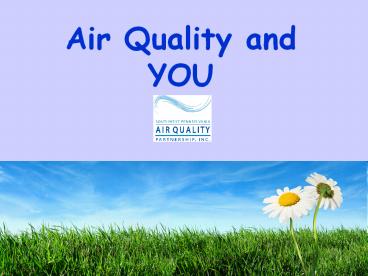Air Quality and YOU - PowerPoint PPT Presentation
Title:
Air Quality and YOU
Description:
Title: Coal generates 54% of our electricity, and is the single biggest air polluter in the U.S. Author: David Mazza Last modified by: Sarah Alessio – PowerPoint PPT presentation
Number of Views:64
Avg rating:3.0/5.0
Title: Air Quality and YOU
1
Air Quality and YOU
2
Quality of Air Quality of Life
3
Air pollution is the primary cause of respiratory
illness worldwide
4
Clean Air Act
- Created in 1970 Amendments added in 1977 1990
- National Ambient Air Quality Standards
- Primary standards
- set limits to protect public health
- Secondary standards
- set limits to protect public welfare, including
protection against decreased visibility, damage
to animals, crops, vegetation, and buildings
5
Under the Clean Air ActEPA has the
responsibility to
- Conduct periodic reviews of the NAAQS for the six
principal pollutants - Ensure that air quality standards are met
- Reduce emissions of SO2 and NOx that cause acid
rain. - And
6
- Reduce air pollutants such as PM, SOx, and NOx,
which can reduce visibility across large regional
areas - Ensure that sources of toxic air pollutants that
may cause cancer and other adverse human health
and environmental effects are well controlled and
that the risks to public health and the
environment are substantially reduced.
7
Six Common Air Pollutants
- Ozone
- Nitrogen Dioxide
- Particulate Matter
- Carbon Monoxide
- Sulfur Dioxide
- Lead
8
Units of measure for the "criteria"pollutants
are
- Parts per million (ppm) by volume
- Milligrams per cubic meter of air (mg/m3)
- Micrograms per cubic meter of air (µg/m3).
9
Air Pollution Trends Trackedby the EPA
- Air Concentrations
- actual measurements of pollutant concentrations
in the ambient (outside) air at selected
monitoring sites throughout the country - Emissions
- engineering estimates of the total tons of
pollutants released into the air each year.
10
- Ground-level Ozone
11
What is ozone?
- Ozone is a gas that occurs both in the Earth's
upper atmosphere and at ground level. - Ozone can be "good" or "bad" for your health and
the environment, depending on its location in the
atmosphere.
12
How Can Ozone Be Both Good and Bad?
13
(No Transcript)
14
- Here, ground-level or "bad" ozone is an air
pollutant that is harmful to breathe - It is a main ingredient of urban smog.
- It damages crops, trees and other vegetation
15
-Extends upward from about 6 to 30 miles
-Good Ozone is produced naturally in the
stratosphere -It protects life on Earth from the
sun's harmful ultraviolet (UV) rays.
16
(No Transcript)
17
Some of the major sources of NOx and VOCs
- Gasoline vapors
- Chemical solvents
- Emissions from
- -Industrial facilities
- -Electric utilities
- -Motor vehicle exhaust
18
(No Transcript)
19
Coal generates 54 of our electricity, and is the
single biggest air polluter in the U.S.
- Burning coal causes smog, soot, acid rain, global
warming, and toxic air emissions.
20
In an average year, a typical coal plant
generates
21
10,200 tons of nitrogen oxide (NOx), as much
as would be emitted by half a million late-model
cars.
NOx leads to formation of ozone (smog) which
inflames the lungs, burning through lung tissue
making people more susceptible to respiratory
illness.
22
and220 tons of hydrocarbons, volatile organic
compounds (VOC), which form ozone.
23
Gasoline-Powered Vehicles
- Spew 205,596 tons of VOCs
- 207,384 tons of NOX into the air annually
24
How Does "Bad" Ozone Affect Human Health and
the Environment?-Chest pain, coughing, throat
irritation, and congestion. -It can worsen
bronchitis, emphysema, and asthma.- Can reduce
lung function and inflame the linings of the
lungs. Repeated exposure may permanently scar
lung tissue.
25
NOx and ozone can also affect crops and other
plants.
26
What YOU Can Do
- Conserve energy
- Follow gasoline refueling instructions for
efficient vapor recovery. - Keep car, boat, and other engines tuned up
- Be sure your tires are properly inflated
- Carpool, use public transportation, bike, or walk
27
More that YOU Can Do
- Use environmentally safe paints and cleaning
products - Follow manufacturers' recommendations for use and
properly seal cleaners, paints, and other
chemicals to prevent evaporation into the air.
28
Drive fuel efficient vehicles
29
Invest in renewable energy
30
Use Energy Star appliances
31
Use non-toxic products whenever possible
32
Switch from incandescent light bulbs to Compact
Fluorescent Lamps (CFLs)
33
Air Quality Action Day tips
- Conserve electricity and set your air conditioner
at a higher temperature - Choose a cleaner commuteshare a ride to work or
use public transportation. Bicycle or walk to
errands when possible. - Defer use of gasoline-powered lawn and garden
equipment.
34
And
- Refuel cars and trucks after dusk.
- Combine errands and reduce trips
- Limit engine idling.
- Use household, workshop, and garden chemicals in
ways that keep evaporation to a minimum, or try
to delay using them when poor air quality is
forecast.
35
If EVERYONE pitches in and does what he/she can
do,we can all breathe a breath of fresh air!































